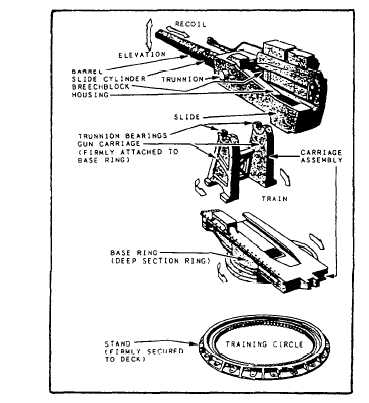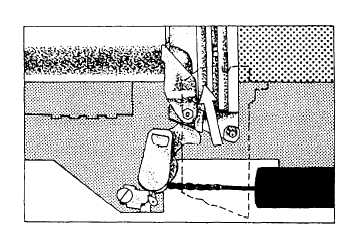| |
Figure 6-10.–Gun-positioning equipment.
Base Ring
The base ring is also called the lower carriage. It is
the rotating platform, supported by the stand, and
supports the upper carriage.
Gun Carriage and Trunnion Bearing
The gun carriage is also called the upper carriage.
It is a massive pair of brackets that holds the trunnion
bearings. The trunnion bearings support the trunnions,
which are part of the slide; together they form the
elevation pivot point.
Slide
The slide is a rectangular weldment that supports all
of the elevating parts of the gun.
FIRING EQUIPMENT
Firing equipment includes all the components
necessary to allow the gun to safely fire, absorb the
shock of recoil, and reposition for further firing. This
includes the housing, breechblock, recoil, counter-recoil
systems, firing circuits, and firing cutouts.
Figure 6-11.–The sliding-wedge breechblock.
Housing
The housing is a large steel casement in which the
barrel and breechblock are fitted. The housing moves in
recoil inside the slide.
Breechblock
The breechblock seals the breech end of the barrel.
The sliding-wedge-type breechblock (fig. 6-11) consists
of a machined steel plug that slides in a grooved way in
the housing to cover the breech opening. The grooves
are slanted so that the breechblock moves forward as it
covers the back of the casing, edging it in place. All guns
currently use the sliding-wedge-type breechblock.
Recoil System
Normally, a recoil system (fig. 6-12) consists of two
stationary pistons attached to the slide, set in a
liquid-filled cylinder in the housing. As the housing
moves rearward in recoil, the trapped liquid is forced
around the piston head through metered orifices,
slowing the movement of the housing.
Counterrecoil System
A counterrecoil system consists of a piston (or
pistons) set in a pressurized cylinder. As the gun recoils,
the piston protrudes further into the cylinder. After the
force of recoil is spent, the air pressure, acting against
the piston, pushes the housing back into the battery (the
full forward position). The piston may be attached to the
slide, allowing the cylinder (which is machined into the
housing) to slide over it during recoil (fig. 6-13). Later
guns use two free-floating pistons set in an air chamber
mounted to the inside of the slide (fig. 6-14). Air pressure
6-16
|


